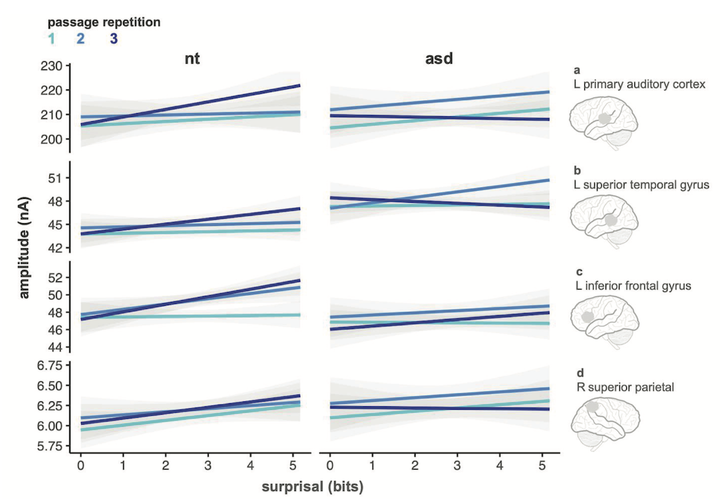Neelima Wagley (Umich Ph.D. 2019, now post-doc at Vanderbilt) has published a wonderful MEG study testing the brain bases of how school-aged children learn the statistical regularities of speech. Her study uses a naturalistic approach pioneered by Jessica Hay (UT Knoxville) of the classic statistical learning paradigm for syllabic sequences. While traditionally that work relies on artificially constructed syllable sequences to tightly control statistical regularities, Hay’s approach uses a natural language that is foreign to the participants. Natural (but semantically vacuous) passages are constructed that vary the within- and between-word transition probabilities between target syllables. Wagley adapted this design for use with children with and without ASD while undergoing MEG scanning. She finds that temporal and frontal areas in neuro-typical children rapidly develop sensitive to these statistical regularities, but no such pattern of “learning” in these regions is seen in children with ASD.
Wagley, N., Kovelman, I., Lajiness-O’Neill, R., Hay, J. S. F., Ugolini, M., Bowyer, S. M., & Brennan, J. R. (2020). Predictive processing during a naturalistic statistical learning task in ASD. eNeuro doi: 10.1523/ENEURO.0069-19.2020
Abstract:
Children’s sensitivity to regularities within the linguistic stream, such as the likelihood that syllables co-occur, is foundational to speech segmentation and language acquisition. Yet, little is known about the neurocognitive mechanisms underlying speech segmentation in typical development and in neurodevelopmental disorders that impact language acquisition such as Autism Spectrum Disorder (ASD). Here, we investigate the neural signals of statistical learning in 15 human participants (children ages 8-12) with a clinical diagnosis of ASD and 14 age- and gender-matched typically developing peers. We tracked the evoked neural responses to syllable sequences in a naturalistic statistical learning corpus using magnetoencephalography (MEG) in the left primary auditory cortex, posterior superior temporal gyrus, and inferior frontal gyrus, across three repetitions of the passage. In typically developing children, we observed a neural index of learning in all three regions of interest, measured by the change in evoked response amplitude as a function of syllable surprisal across passage repetitions. As surprisal increased, the amplitude of the neural response increased; this sensitivity emerged after repeated exposure to the corpus. Children with ASD did not show this pattern of learning in all three regions. We discuss two possible hypotheses related to children’s sensitivity to bottom-up sensory deficits and difficulty with top-down incremental processing.

